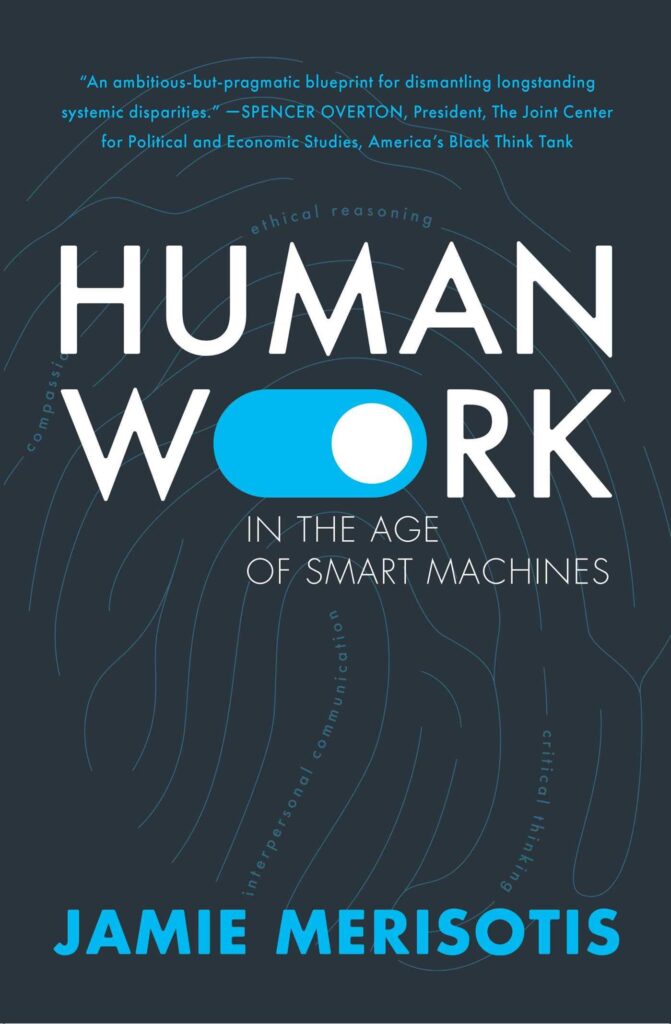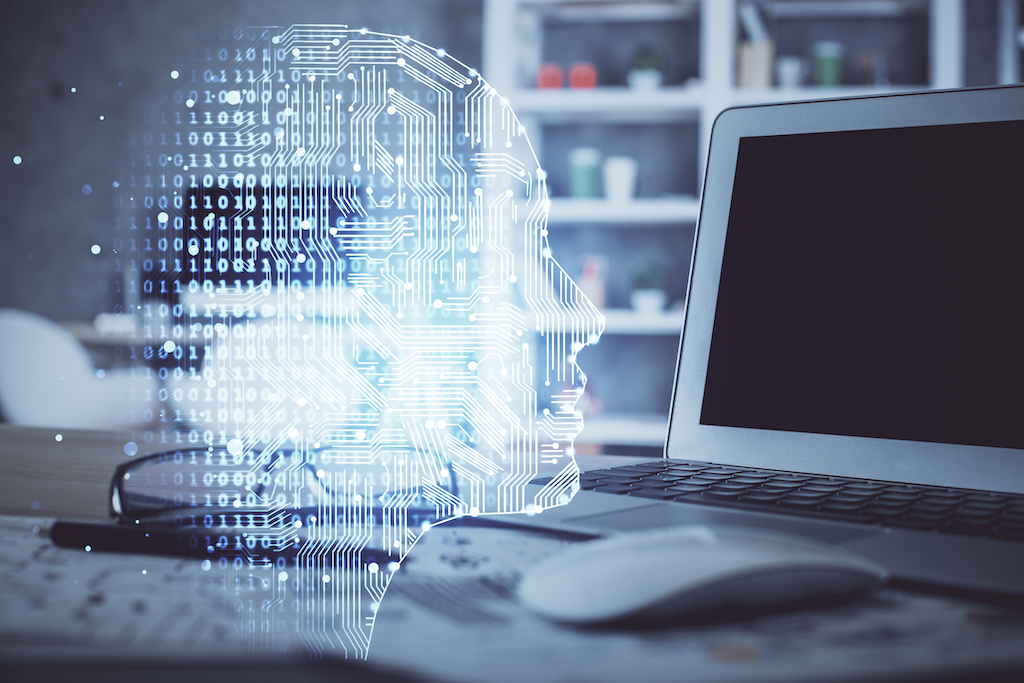Note: This is the first article in a two-part series on the Jamie Merisotis book, “Human Work in the Age of Smart Machines,” concerning the use of artificial intelligence (AI) in the workplace and how the workforce will need to adapt to the challenge of working alongside smart machines.
When I read a short blurb about the latest book authored by Lumina CEO Jamie Merisotis, Human Work in the Age of Smart Machines, I was skeptical that anyone would be able to make an argument that the number of jobs will increase as AI continues to be embraced by more and more companies. After reading and rereading Human Work, I continue to be a skeptic, but I am more of a believer in the methodology proposed by Mr. Merisotis.
In an opening chapter, How Work is Being Transformed, Mr. Merisotis writes that he believes the preoccupation with job loss due to the implementation of AI is misplaced. It would be better, he writes, if we think less about the future of work and more about the work of the future.
What’s more important, Merisotis states, is that everyone will see their jobs change in some way by technology and will need additional learning to take advantage of the opportunities for work that will be created. In 2020, technology has impacted all occupations in the U.S., with half of all tasks designated “uniquely human” versus just 30 percent designated as such in 2000. Mr. Merisotis writes that projections of these trends indicate that the percentage of tasks designated as “uniquely human” will increase to 80 percent over the next 10 years.
Human work, the work that only people can do, is the work that Mr. Merisotis believes is what our collective future will be based upon. People will need to develop the knowledge, skills, and expertise that human work requires.

For instance, the jobs created will require high-level cognitive skills such as complex problem solving, critical thinking, and creativity. They will also require social intelligence such as the social perceptiveness needed when one is persuading, negotiating, and caring for others.
Globally, nearly half of adults have only a basic ability to solve problems utilizing technology. In the U.S., the number of jobs requiring only a high school diploma has shrunk from 33 percent to 20 percent over the past three decades. Good jobs have increased, but they are going to people with post-secondary credentials.
According to Mr. Merisotis, there are four kinds of occupations emerging that embody human work. These are helpers, bridgers, integrators, and creators.
- Helpers are people in occupations involving deep personal interaction with other people. Customer service roles and many healthcare roles are helping professions.
- Bridgers are people who interact with others, perform technical tasks, and help run systems. Sales managers and many supervisors fall into this category.
- Integrators are people who integrate knowledge and skills from a range of fields and apply them in a highly personal way. Social workers and elementary teachers are excellent examples of Integrators.
- Creators are people who possess highly technical skills and pure creativity. Examples provided by Mr. Merisotis include several entrepreneurs who leveraged technology to build nationwide businesses, which was not possible without harnessing the Internet and other technologies.
Mr. Merisotis outlines the exponential increase in knowledge growth over the past century including the most recent decade of advancement, but writes that knowledge obsolescence is also a factor in careers almost as much as knowledge acquisition is a factor. According to him, there is no way we can prepare people for work using old models of learning based on mastery of knowledge.
We need to change our education systems to embrace wide learning. Three sets of skills will be required for human work: people skills, problem-solving skills, and integrative skills.
Innovations enabled by AI will create new capabilities, products, and services. These innovations will increase the importance of people skills and person-to-person relationships. One people skill that underlies all others, according to Mr. Merisotis, is empathy.
Problem solving is on everyone’s list for future work, but it’s seldom explained because it’s a multi-stage, complex process. Stage one is identifying or diagnosing the problem, which may require analyzing data, insights from personal interactions, or using whatever other information is available. Solving the problem requires subject matter or technical expertise and the ability to think creatively.
Because of the ever-changing nature of work and the fact that people need to keep learning throughout their lives, the ability to learn is an essential skill for human work. In a world where human work is constantly changing, it’s not either/or.
Everyone needs a combination of general and technical learning. What’s important to human work is integrating them.
According to Mr. Merisotis, human work requires us to rethink every aspect of how we provide everyone the opportunity to learn, because the learner must be at the center of the system. Currently, there are two dominant processes for learning. Workforce training prepares individuals quickly for specific tasks. Education prepares people for life beyond work.
For the most part, these two processes are treated as different activities and handled by different systems. Academics state that they are educators and not trainers. Higher education looks like training for academics to many of our public today.
Mr. Merisotis writes that each of these two systems is missing a critical component. Workforce training lacks broader learning, and most education doesn’t prepare individuals directly for work. What is needed, he argues, is a broad, integrated system focused on individual learners.
The new “system” needs to solve three problems related to preparing individuals for future work:
- Problem 1: More people need higher-level learning. High school is no longer enough. At the same time, few of today’s colleges have adapted their systems to accommodate the profile of today’s learner who is older, works full-time, and goes to school part-time.
- Problem 2: We don’t do a good job developing skills that human work requires. You don’t learn these skills sitting passively in a lecture hall. One of the best ways to learn skills for human work is by actually doing human work.
- Problem 3: We don’t know what graduates have learned. The solution to this problem, writes Mr. Merisotis, is to assure the transparency of learning by defining clear frameworks for knowledge and skills so that employers, educators, and student workers are all speaking the same language about skills. Transparency about learning will build stronger credentials and multiple pathways for individuals for learning and careers.
Credentials document the knowledge and skills that people have and presumably, that jobs require. A college degree is a credential — specifically, one that is required for many jobs. People with degrees may also have credentials.
For example, licenses are issued by states in the fields of law, medicine, nursing, accounting, engineering, and architecture. Employers use credentials beyond degrees to make it clear what the knowledge and skill requirements are for open jobs.
Mr. Merisotis writes that the information technology (IT) field may be the area of employment where the range of credentials is widest. Approximately 85 percent of IT professionals have at least one certification. Many have several.
In addition, nearly 70 percent are pursuing their next certification. Clearly, the rapidly changing technology field impacts its chief workers as much or more as it impacts its users.
Looking at degrees from a credential perspective, Mr. Merisotis writes that high school degrees are an inadequate credential, as they provide no indication of the skills and knowledge of the individual who is awarded the degree. And while college degrees provide an indication of additional learning over a period of time, they do not provide a clear indication of what most graduates have learned. The problem, according to Mr. Merisotis, is a lack of transparency.
Three problems that need to be overcome for individuals to be prepared for a world of human work are:
- Problem 1: It’s not clear what most credentials represent in terms of knowledge, skills, and abilities. Nearly 740,000 unique credentials are issued by colleges, workforce agencies, licensing entities, and other issuers in the United States. Most have value in the labor market, but there is a lack of transparency about what those credentials represent. Credentials should not represent the kind of experience an individual has had, but they should represent the knowledge and skills they have obtained.
- Problem 2: Employers, educators, and individuals all speak different languages when it comes to knowledge and skills. The primary example of the schism between employers and educators is that 96 percent of chief academic officers believe their colleges do a good job preparing graduates, while only 11 percent of business leaders say that higher education is producing graduates with the skills that they need. Transparent credentials would define the terms of learning accomplished in a manner that learners and workers, education providers, and employers would understand.
- Problem 3: Pathways through education and careers are either nonexistent or nearly impossible for outsiders to fathom. For many college graduates seeking jobs, they have no indication whether the vague statements on job position postings such as “effective problem solver” are met by the degree that they earned at their specific institution. Employers have the same problem from the other side, as they don’t know what applicants actually know or what their skills are.











